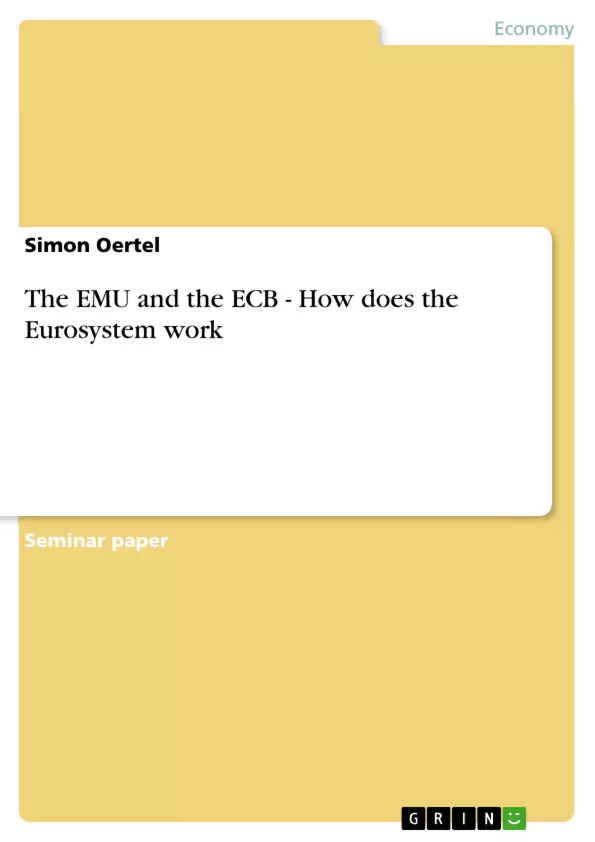The creation of the European Monetary Union (EMU) and the introduction of the euro has been an experiment without comparable predecessor. The euro area combined has the second largest GDP in the world, only outperformed by the United States. Therefore, this historical event has been widely discussed, in different academic fields (economics, sociology, history, psychology and others), in different countries, and of course bars, newspapers and TV shows all around the world. As with probably every event of this impact, the opinions on whether the euro is a success or not are widely spread. This paper tries to give a brief overview on two major topics: the Stability and Growth Pact which sets the rules for the countries participating in EMU and the European Central Bank, the newly created institution which is set up to guard the price stability in the euro area and the confidence in the euro. The paper will first give an historical overview on the events that led to the creation of EMU, then, it introduces the Stability and Growth Pact (SGP) and the Maastricht Criteria. The field of economics is divided between supporters and opponents of the SGP therefore, their different points of view will be presented. Thereafter, the recent developments in the euro area will be discussed. The second part will present the ECB, the system it operates in and its functions. In order to include international financial theory, I briefly discuss the ECB’s monetary policy and its influence on inflation. Last but not least, a conclusion will present arguments for and against a successful euro, and also present my personal point of view. [...]
Inhaltsverzeichnis (Table of Contents)
- Introduction
- 1. Historical Background
- 1.1. The Road to the Euro (until 1999)
- 1.2. The Stability and Growth Pact (The Maastricht Criteria)
- 1.3. The Experiment Begins (1999-today)
- 2. Central Banking in Europe
- 2.1. The European Central Bank
- 2.2. The ECB's Monetary Policy
- 3. Conclusion
Zielsetzung und Themenschwerpunkte (Objectives and Key Themes)
This paper aims to provide a comprehensive overview of the European Monetary Union (EMU) and the European Central Bank (ECB), focusing on their roles in safeguarding price stability and fostering confidence in the euro. The paper explores the key historical events leading up to the creation of EMU, including the Stability and Growth Pact and the Maastricht Criteria, and analyzes the structure and functions of the ECB within the broader context of international financial theory.
- The historical development of the euro and its underlying economic and political motivations.
- The role of the Stability and Growth Pact in promoting budgetary discipline within EMU.
- The structure and functions of the European Central Bank in maintaining price stability and influencing inflation.
- The economic and social impacts of the euro and its effects on intra-European trade and economic integration.
- The challenges and opportunities facing the euro area in the future.
Zusammenfassung der Kapitel (Chapter Summaries)
- Introduction: This introductory chapter establishes the context of the euro as a groundbreaking experiment in monetary integration, highlighting its global significance and the diverse perspectives surrounding its success. It outlines the paper's focus on the Stability and Growth Pact, the ECB, and the historical events leading to their formation.
- 1. Historical Background: This chapter traces the journey towards the euro, beginning with the Treaty of Rome and the Bretton Woods system, and explores the subsequent challenges and efforts towards monetary integration. It examines the creation of the European Monetary System (EMS) and its role in fostering stability and facilitating economic convergence.
- 1.1. The Road to the Euro (until 1999): This section delves deeper into the historical context, analyzing the motivations behind the Single European Act and its impact on the trajectory towards a single currency. It discusses the Delors Report and its three-stage plan for economic and monetary union, culminating in the signing of the Maastricht Treaty.
- 1.2. The Stability and Growth Pact (The Maastricht Criteria): This section explores the importance of the Maastricht Criteria, focusing on the fiscal rules and economic convergence criteria established to govern the participating countries. It analyzes the rationale behind these criteria and their role in ensuring sustainable economic growth within EMU.
- 1.3. The Experiment Begins (1999-today): This section discusses the initial phase of the euro, highlighting the establishment of the European Monetary Institute (EMI) and the official adoption of the euro as the currency of the Eurozone. It also explores the subsequent developments and challenges faced by the euro area.
- 2. Central Banking in Europe: This chapter introduces the European Central Bank (ECB) as the central institution responsible for maintaining price stability and managing the euro. It analyzes the ECB's structure, governance, and operational mechanisms within the broader context of European monetary policy.
- 2.1. The European Central Bank: This section delves into the specific organization and responsibilities of the ECB, explaining its independence, decision-making processes, and key functions within the euro area.
- 2.2. The ECB's Monetary Policy: This section explores the ECB's monetary policy framework, including its tools and strategies for managing inflation and ensuring price stability. It analyzes the impact of the ECB's actions on interest rates, exchange rates, and overall economic growth within the euro area.
Schlüsselwörter (Keywords)
The key keywords and focus topics of this work are: European Monetary Union (EMU), euro, European Central Bank (ECB), Stability and Growth Pact, Maastricht Criteria, monetary integration, price stability, inflation, exchange rates, economic convergence, and international financial theory.
- Citation du texte
- Simon Oertel (Auteur), 2005, The EMU and the ECB - How does the Eurosystem work, Munich, GRIN Verlag, https://www.grin.com/document/66600



